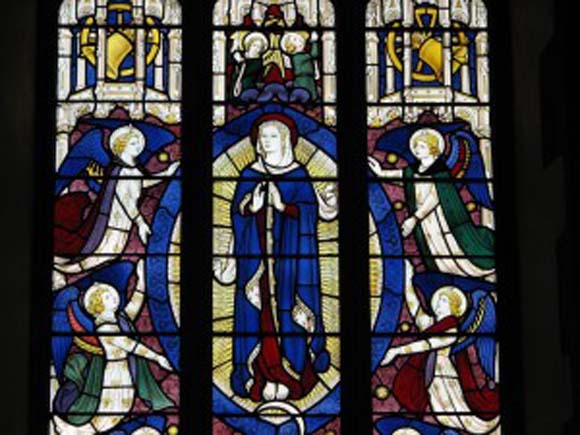
Healing for Mary’s Dowry
During the John Paul II Pilgrimage to Walsingham, Br Lawrence Lew OP gave the following talk which we reproduce here for the Feast of the Assumption:
“Chaucer in the Prologue to his Canterbury Tales says that after the April rains, people long to go on pilgrimages and so, he fell in with 29 others who were journeying to Canterbury. That was in the 14th-century when the tradition of calling England ‘The Dowry of Mary’ was already well established.
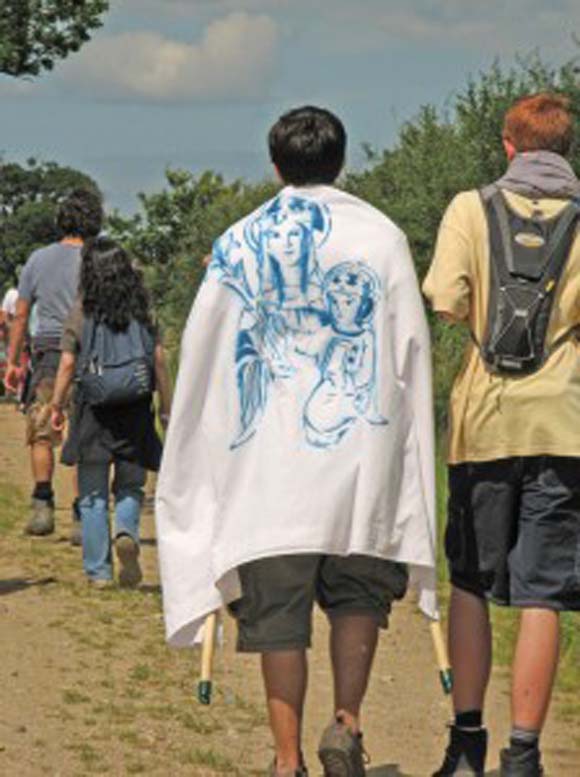 We 21st century pilgrims follow in the tradition of Chaucer and his folk in ways both alike and different. Unlike them, we are clearly not walking after the rains have ceased, and the shrine of St Thomas of Canterbury no longer exists. But we are a similar band of twenty-odd pilgrims, journeying to the heart of Mary’s Dowry, to her shrine at Walsingham. Soon, we shall pray in the Slipper Chapel which was built just half a century before Chaucer wrote his Tales. Some of us even look similar to those pilgrims because of the medieval habits we wear, although it is hoped that the religious and clergy in our band are less quarrelsome, and maybe just slightly less bawdy! But despite these differences, we can be certain that the essence of our pilgrimages, though separated by seven centuries, is the same.
We 21st century pilgrims follow in the tradition of Chaucer and his folk in ways both alike and different. Unlike them, we are clearly not walking after the rains have ceased, and the shrine of St Thomas of Canterbury no longer exists. But we are a similar band of twenty-odd pilgrims, journeying to the heart of Mary’s Dowry, to her shrine at Walsingham. Soon, we shall pray in the Slipper Chapel which was built just half a century before Chaucer wrote his Tales. Some of us even look similar to those pilgrims because of the medieval habits we wear, although it is hoped that the religious and clergy in our band are less quarrelsome, and maybe just slightly less bawdy! But despite these differences, we can be certain that the essence of our pilgrimages, though separated by seven centuries, is the same.
The medieval pilgrims travelled to Canterbury to look for a miracle, and particularly for healing. Chaucer says, “Of England to Canterbury they wend, the holy blissful martyr for to seek, who helped them when they were sick”. And we? Why do we walk in this manner to Walsingham? Are we sick? What do we seek from the holy blissful Virgin Mother of God?
We may not be physically unwell, at least not yet, but we are certainly all wounded and in need of God’s healing, “for all have sinned and fall short of the glory of God.” We have sustained the wounds of original sin, and the wounds that a sin-filled world inflicts on us. Thus, pilgrimages are undertaken as an act of penance. The sacrifice and hardship of a pilgrimage is a vital reminder of Christ’s call that we should deny ourselves, take up our Cross and follow him. So, this pilgrimage is a living enactment of the sequela Christi, the following of Christ, even if on this walk, we are not carrying a physical Cross. And in this act of following Christ, we find life, healing and salvation, for if we have died with Christ, we shall rise with him and reign with him.
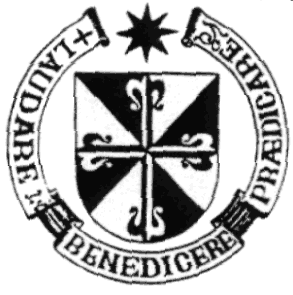 In 1400, Thomas Arundel, Archbishop of Canterbury, said: “…we English being the servants of her special inheritance, and her own Dowry, as we are commonly called, ought to surpass others in the fervour of our praise and devotion.” That is the goal for England and I think we here certainly share some of that praise, devotion and fervour. There is a Dominican motto, emblazoned on the logo of Blackfriars Hall in Oxford: laudare, benedicere, praedicare; to praise, to bless, to preach. Let it be our motto and a reminder of our goal as Mary’s Dowry: let us praise God, let us bless His holy name with devotion, and let us preach his Gospel of salvation with fervour.
In 1400, Thomas Arundel, Archbishop of Canterbury, said: “…we English being the servants of her special inheritance, and her own Dowry, as we are commonly called, ought to surpass others in the fervour of our praise and devotion.” That is the goal for England and I think we here certainly share some of that praise, devotion and fervour. There is a Dominican motto, emblazoned on the logo of Blackfriars Hall in Oxford: laudare, benedicere, praedicare; to praise, to bless, to preach. Let it be our motto and a reminder of our goal as Mary’s Dowry: let us praise God, let us bless His holy name with devotion, and let us preach his Gospel of salvation with fervour.
We are also walking this pilgrimage for another reason, with the intention of evangelising England. Our society is clearly sick. All around us, symptoms of its illness can be seen, and yet our fellow countrymen do not recognise and acknowledge their need for the Divine Physician. Christ has come to call sinners to repentance, that we might have life to the full. What sick person does not go to a doctor? The one who doesn’t know he is sick, and so the disease silently kills the person. England needs a doctor, our society needs Christ and it cries out for Him minute by minute. Indeed, England’s need, and our need, is for salvation, for that word, ‘salvation’, is derived from the Latin salus, meaning health. Let every step we take be a prayer for our nation that she may come to realize her need for the healing that only Jesus, the Saviour of all people, brings.
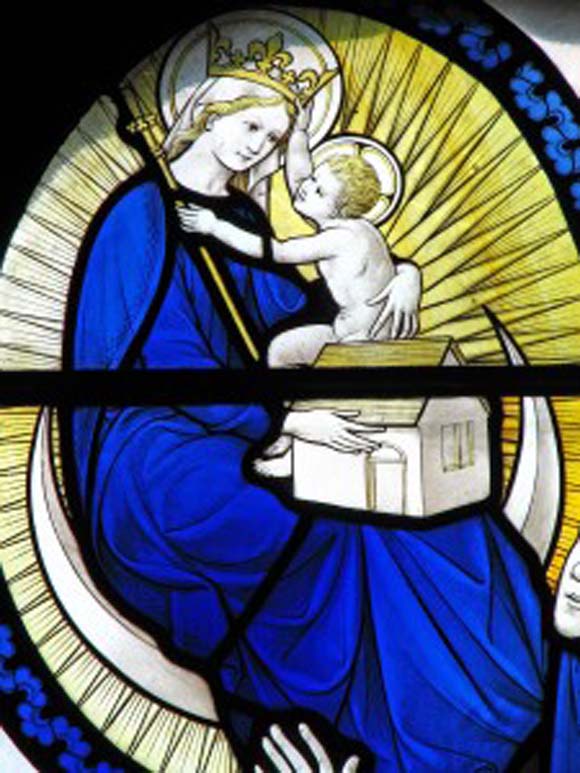 What exactly is a dowry? Basically, it is a present given to a new husband by the bride upon marriage. It took the form of land, goods or money. Why is a dowry given? Because a wedding is near. But whose wedding is near? Every Sunday at Vespers we sing: “Alleluia. The marriage of the Lamb has come. And His bride has made herself ready.” So the wedding that is near, is that of the Lamb, Christ himself. It is the banquet of all the blessed in heaven. The bride is the Church, and the image of the Church is none other than Our Lady. The idea of the Dowry of Mary is profoundly connected to the gift of England – as a people – to Christ at his wedding banquet. Are we ready for that wedding? Yes, and no.
What exactly is a dowry? Basically, it is a present given to a new husband by the bride upon marriage. It took the form of land, goods or money. Why is a dowry given? Because a wedding is near. But whose wedding is near? Every Sunday at Vespers we sing: “Alleluia. The marriage of the Lamb has come. And His bride has made herself ready.” So the wedding that is near, is that of the Lamb, Christ himself. It is the banquet of all the blessed in heaven. The bride is the Church, and the image of the Church is none other than Our Lady. The idea of the Dowry of Mary is profoundly connected to the gift of England – as a people – to Christ at his wedding banquet. Are we ready for that wedding? Yes, and no.
The fact is that we, who are baptised and saved by Jesus, are already invited to this marriage feast and share in its delights. As Pope Benedict said: “For us, the Eucharistic banquet [the Mass] is a real foretaste of the final banquet foretold by the prophets and described in the New Testament as ‘the marriage-feast of the Lamb’, to be celebrated in the joy of the communion of saints.” But in another sense, we are still not there yet. We are the Church Militant, fighting the good fight – as St Paul puts it – and running the race. We are on the way, pilgrims in via, learning to perfect how we praise, bless and preach. As such, a pilgrimage like this reminds us of the journey that we are all on together, moving towards heaven, our true homeland. The Dominican Archbishop of Vienna, Cardinal Christoph Schoenborn, once said that Christians suffer from “eschatological amnesia”. What he meant is that often we live and work as if this life is all that mattered, forgetting that we are actually pilgrims travelling through this life on the way home to God. To be a pilgrim is to have a destination in mind, to be continually moving towards it, and our goal is God Himself and the life of beatitude with and in Him.
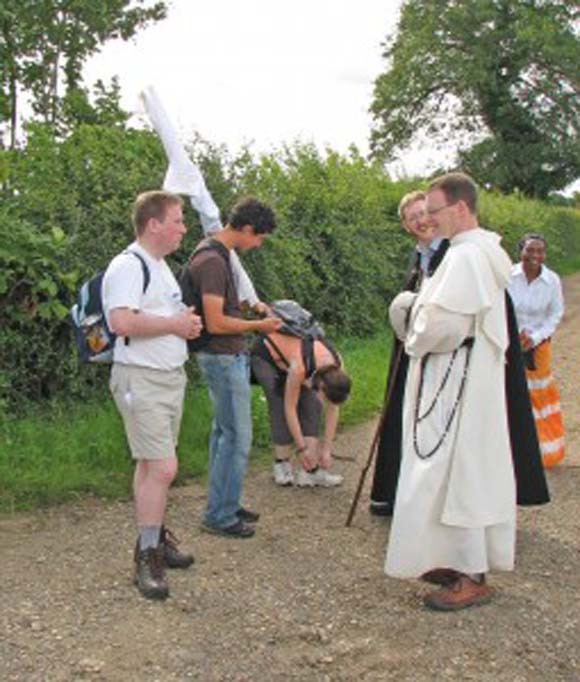 This should not be taken to mean that we ignore the plight of our fellow travellers. No. We journey together, we help those who lag behind and we support one another, for we are called to love God and to love our neighbour. Indeed, St Augustine said that “If you see charity, you see the Trinity”. In a sense then, Christian charity in action is a foretaste of the beatific vision. Thus, Pope Benedict wrote in his first encyclical that “Love of neighbour, grounded in the love of God, is first and foremost a responsibility for each individual member of the faithful… For the Church, charity is not a kind of welfare activity which could equally well be left to others, but is a part of her nature, an indispensable expression of her very being.” The Holy Father goes on to say that “practical activity will always be insufficient, unless it visibly expresses a love for man, a love nourished by an encounter with Christ. My deep personal sharing in the needs and sufferings of others becomes a sharing of my very self with them… I must give to others not only something that is my own, but my very self; I must be personally present in my gift.” Here we have an explanation of how we can best become Mary’s Dowry: through love, the kind of love in which we are ourselves the gift, given to others, for the love of Christ.
This should not be taken to mean that we ignore the plight of our fellow travellers. No. We journey together, we help those who lag behind and we support one another, for we are called to love God and to love our neighbour. Indeed, St Augustine said that “If you see charity, you see the Trinity”. In a sense then, Christian charity in action is a foretaste of the beatific vision. Thus, Pope Benedict wrote in his first encyclical that “Love of neighbour, grounded in the love of God, is first and foremost a responsibility for each individual member of the faithful… For the Church, charity is not a kind of welfare activity which could equally well be left to others, but is a part of her nature, an indispensable expression of her very being.” The Holy Father goes on to say that “practical activity will always be insufficient, unless it visibly expresses a love for man, a love nourished by an encounter with Christ. My deep personal sharing in the needs and sufferings of others becomes a sharing of my very self with them… I must give to others not only something that is my own, but my very self; I must be personally present in my gift.” Here we have an explanation of how we can best become Mary’s Dowry: through love, the kind of love in which we are ourselves the gift, given to others, for the love of Christ.
In a recent letter to Chinese Catholics, the Pope explained how a nation is brought to know and love Christ. I think his words can also apply to us in England and remind us how we can most effectively praise, bless and preach. Pope Benedict said: “Today, as in the past, to proclaim the Gospel means to preach and bear witness to Jesus Christ, crucified and risen, the new Man, conqueror of sin and death. He enables human beings to enter into a new dimension, where mercy and love shown even to enemies can bear witness to the victory of the Cross over all weakness and human wretchedness. In your country too, the proclamation of Christ crucified and risen will be possible to the extent that, with fidelity to the Gospel, in communion with the Successor of the Apostle Peter and with the universal Church, you are able to put into practice the signs of love and unity.” Put into practice love and unity. May this pilgrimage, in which we journey as one and have communion with one another and with the Lord be such a practice, an expression of Christian love. May this pilgrimage truly be a holy preaching, as we praise and bless the Lord together. May our love and unity be a reflection of the life of the Church in our land.
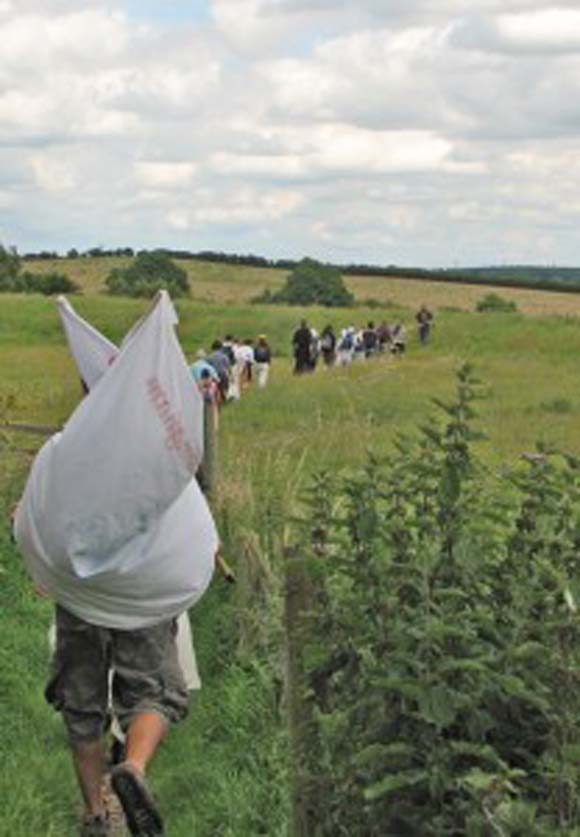 One way we might show our love and unity is through joy, and in song. It is said that our holy father, St Dominic, as he walked the length and breadth of Europe would break out into song. This joy, this confidence in God’s salvation is truly attractive. A few years ago, I’d returned from the Philippines. Sitting on the train from Manchester airport, I noticed how glum and miserable everyone looked, and I noticed this because it was in stark contrast with the joy and cheer I found in the Philippines, Asia’s most Christian country. I hope that we Christians in England are signs of joy in our communities, in our country. May it be a deep joy rooted in our hope of eternal life with God and the saints.
One way we might show our love and unity is through joy, and in song. It is said that our holy father, St Dominic, as he walked the length and breadth of Europe would break out into song. This joy, this confidence in God’s salvation is truly attractive. A few years ago, I’d returned from the Philippines. Sitting on the train from Manchester airport, I noticed how glum and miserable everyone looked, and I noticed this because it was in stark contrast with the joy and cheer I found in the Philippines, Asia’s most Christian country. I hope that we Christians in England are signs of joy in our communities, in our country. May it be a deep joy rooted in our hope of eternal life with God and the saints.
In 1982, at a Mass in Wembley Stadium, Pope John Paul II said: “Brothers and sisters! …We must be a people of prayer and deep spirituality. Our society needs to recover a sense of God’s loving presence, and a renewed sense of respect for his will.” In his words we find inspiration for how, by the grace of God, we may evangelise England, and for what we seek from Our Lady at her Shrine:
“Let us learn this from Mary our Mother. In England, the Dowry of Mary, the faithful, for centuries, have made pilgrimage to her shrine at Walsingham. The statue of Our Lady of Walsingham, present here, lifts our minds to meditate on our Mother. She obeyed the will of God fearlessly and gave birth to the Son of God by the power of the Holy Spirit. Faithful at the foot of the Cross, she then waited in prayer for the Holy Spirit to descend on the infant Church. It is Mary who will teach us how to be silent, how to listen for the voice of God in the midst of a busy and noisy world. It is Mary who will help us to find time for prayer. Through the Rosary, that great Gospel prayer, she will help us to know Christ. We need to live as she did, in the presence of God, raising our minds and hearts to him in our daily activities and worries …Certainly, our fidelity to the Gospel will put us at odds with the spirit of the present age. Yes, we are in the world, indeed as disciples of Christ we are sent into the world, but we do not belong to the world. The conflict between certain values of the world and the values of the Gospel is an inescapable part of the Church’s life, just as it is an inescapable part of the life of each one of us. And it is here that we must draw on the patience which Saint Paul spoke about in his letter to the Romans: ‘we groan inwardly as we await our salvation, in hope and with patience.'”
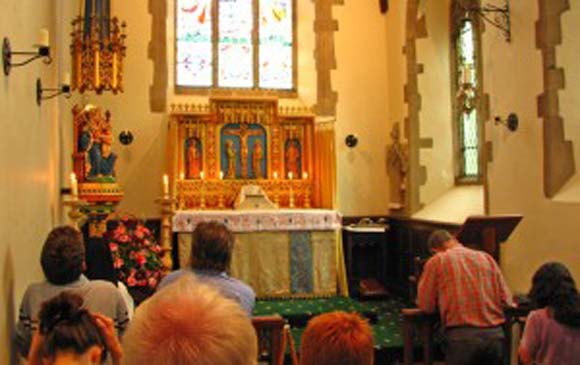 I think this pilgrimage is just one of many signs of England’s own pilgrim journey home to God. There are so many signs of hope in the Church in England, little acts of praise, devotion and fervour … let us thank God for these works of His grace, and walk this pilgrimage as an act of thanksgiving.
I think this pilgrimage is just one of many signs of England’s own pilgrim journey home to God. There are so many signs of hope in the Church in England, little acts of praise, devotion and fervour … let us thank God for these works of His grace, and walk this pilgrimage as an act of thanksgiving.
At the end of this pilgrimage, our feet may well need healing, but we know that by God’s grace, our hearts and souls will have been healed a little more; healed by the love and unity in Christ that we have found. At the very least, we should be more united and loving than Chaucer’s pilgrims! Only then can our witness be genuine. Let us pray that God’s Holy Spirit will use this love and unity, which he has stirred up among us, to heal England, so that we may once more be called ‘Dowry of Mary’, a people given to Jesus and ready for his eternal wedding banquet.”


